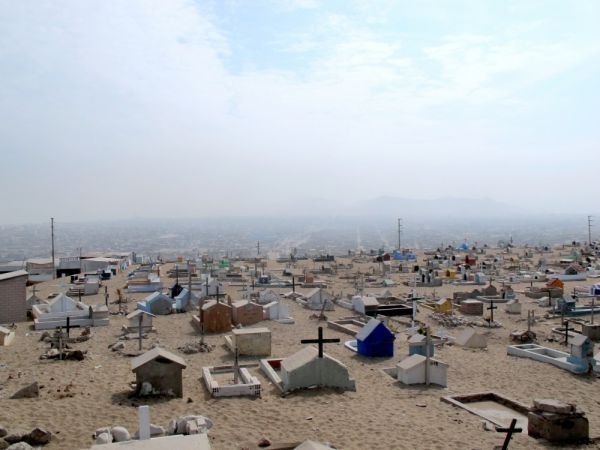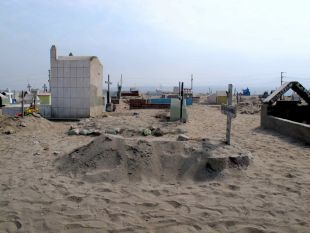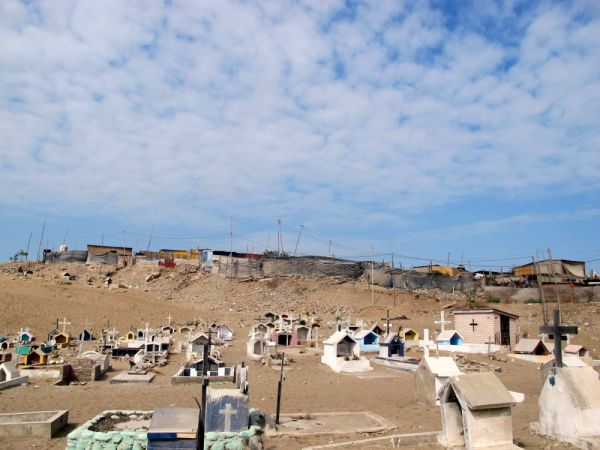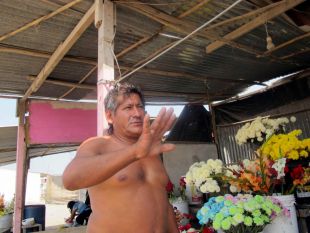An Informal Cemetery Copes With Unwanted Newcomers: The Living

Cristo El Salvador Cemetery was built in 1986 on a hill that overlooks the entire district. Shortly after it opened, an informal cemetery popped up right next door. Photo credit: Manuel Vigo
“It’s funny how life is shared from behind tombstones,” says a voice. It’s a startling introduction, especially coming from behind me in a desolate cemetery. I wheel around and find myself face to face with Raul Castro.
“Like the Cuban president,” Castro explains with the stern demeanor of an actual dictator. A self-proclaimed former track star who was injured during his part-time job as a garbage collector, Castro is now one of the caretakers at Cristo El Salvador, a cemetery located in Villa El Salvador, a district of Lima that began as a shantytown on the outskirts of the capital in the early ’70s.
Back then, this area was strewn with a few hundred homes built out of matted reeds on sandy hills. Today, Villa El Salvador is a sprawling urban area filled with brick houses and close to half a million inhabitants. Neighbors and city officials built the Cristo El Salvador Cemetery (Spanish for “Christ The Savior”) in 1986 on a hill that overlooks the entire district. Shortly after it opened, an informal cemetery popped up right next door, and quickly became the larger of the two.

In the informal cemetery the memorials range from small yet ornate mausoleums to simple mounds of sand and stone. Photo credit: Manuel Vigo
During the day, Castro hobbles over the cemetery’s uneven grounds, aided by a crutch, removing debris and keeping an eye out for vandals. He tells me the area is reasonably quiet during the day, and that typically his biggest concern is chasing out the local children, who take advantage of the formal cemetery’s smooth concrete surface for skateboarding. “My colleagues who work at night tell me that sometimes junkies come out to the cemetery, looking for an empty crypt, on the higher levels, to sleep in,” he says. The image sends a chill up my spine.
Domingo Lazaro, one of the cemetery’s caretakers, tells me he worked at Cristo El Salvador when it first opened, and dug the first graves. “Back then there was nothing, it was silent,” he says. “There were no homes or anything.” Today there are hundreds of crypts stacked atop one another. Stray dogs roam languidly, their eyes skeptical, looking for shade and water. Dead flowers and beer bottles are sprinkled across the sandy ground, signs of earthly activity.
At the formal cemetery families can buy a small plot, upon which they’re allowed to build four graves high. When someone dies, family members hire a local construction worker to build and decorate the crypt. A man who goes by the name Juanito seems to have a monopoly over this construction work; his workshop, located virtually inside the cemetery, has his cell phone number painted on the side.

Informal dwellings have crept up to the cemetery’s edge. Some lie as close as three feet from the graves. Photo credit: Manuel Vigo
Juanito’s handywork can be found on countless tombs across both the formal and informal cemeteries. Many of the crypts feature unique designs; some have murals and poems inscribed on them. In the informal cemetery the memorials range from small yet ornate mausoleums to simple mounds of sand and stone that lack any sort of identification. The plots are arranged in no discernible order, though most look out toward the homes of Villa El Salvador.
Recently, improvised dwellings have started to invade both cemeteries, some of them less than three feet from the graves.
“They have invaded the land … and over there they have built pig farms, and even a soccer field,” says Castro. One of the local bus lines runs right through the middle of the formal cemetery, providing transit service to the new informal homes.

Ruben, the man who exhumes the bodies as the district clears some of the plots, also runs a flower stand at the cemetery’s entrance. Photo credit: Manuel Vigo
Due to the growing number of anonymous graves, late last year local officials announced an initiative to help identify the close to 6,000 unmarked tombs that lie here. Because the district is now trying to clear out some of the plots, Castro says some people are choosing to exhume their loved ones’ bodies so they can either bury them elsewhere or have them cremated. He points me toward the man who usually deals with the exhumations: Ruben, a muscular fellow in his forties who also runs a flower stand with his wife right in front of the cemetery’s entrance.
“It’s hard to remove the body from the dirt. The land is no longer virgin — it is contaminated,” says Ruben, sounding a bit like a mystic. He says he charges 150 to 200 soles ($58 to $78 USD) to exhume a body, and up to 1,500 soles ($588 USD) to build a crypt. “Today,” he says, “dying is expensive.”
Castro says the cemetery has started to dwindle in popularity because of the informal homes popping up. “Local politicians have started to allow people to invade the land. This cemetery was never meant to be next to houses.”
“It’s strange how the dead and the living live together,” he ruminates. “The water trucks go by here, and the kids start yelling, ‘Water, water!’ And the waterman stops to bring in life, to bring in water.”
Castro says he spends a lot of time thinking about this interplay between life and death, the here and the hereafter. Next to us, a house sits at the edge of the cemetery, its walls painted with white block letters advertising its products: cold beer, and access to a bathroom.
“Even after you’re dead you keep generating money,” says Castro, his gaze low and steady across the endless rows of tombstones. “That’s life.”









